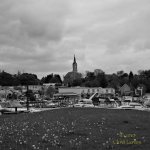You are using an out of date browser. It may not display this or other websites correctly.
You should upgrade or use an alternative browser.
You should upgrade or use an alternative browser.
Post your church shots
- Thread starter jdeg
- Start date
Bikerbrent_RIP
Senior Member
Interesting photo[COLOR=rgb(0, 0, 0)] Gobae[/COLOR]. nicely done!!
Bikerbrent_RIP
Senior Member
Nice church interior!
Silversnapper
Senior Member
I looked back at this church as I left via a side gate and I was taken with the soft mellow glow of the Yorkshire sandstone of its construction and the incongruity of having to lay claim to its own waste bin, albeit in a rather unique manner. Then I read the inscription on the foreground headstone of a couple and their child. I was saddened to read that the mother had passed away only a few short months after their son was born and that he himself had died at the tender age of 22 months. We have much to thank modern medicine and healthcare for.

Clovishound
Senior Member
My wife does genealogy. The abundance of child mortality prior to the 20th century is staggering to those of us use to modern medicine and modern sanitation. Very common to see a couple have 8 -10 children and only a couple make it to adulthood. Often some disease going through would take out a handful of children at one time. Also very common for women to die from childbirth, especially after the number of children and years began to rack up.
Dawg Pics
Senior Member
I used to do cemetery images. The older the cemetery, the better. One of the most interesting monuments was very large. It was a statue of 2 or 3 children. I can't remember now. The base had I think 4 kid's names with one being, "the unamed one." It is sad when. you walk around and see how many kids from the same family died, often within a short time.My wife does genealogy. The abundance of child mortality prior to the 20th century is staggering to those of us use to modern medicine and modern sanitation. Very common to see a couple have 8 -10 children and only a couple make it to adulthood. Often some disease going through would take out a handful of children at one time. Also very common for women to die from childbirth, especially after the number of children and years began to rack up.
Blue439
New member
Now, don’t get me started on churches! You know it is my specialty. 
Two photos inside the Benedictine abbey church of Champagne (still operating) in southeastern France, both taken with a Nikon Z7 II, Micro-Nikkor 85mm, ƒ/2.8 D PC tilt-shift lens, Gitzo tripod, Benro geared head. Natural light.


Two photos inside the Benedictine abbey church of Champagne (still operating) in southeastern France, both taken with a Nikon Z7 II, Micro-Nikkor 85mm, ƒ/2.8 D PC tilt-shift lens, Gitzo tripod, Benro geared head. Natural light.
Blue439
New member
I did have a “cemetery photos” period, too. I was lucky enough to find some tombs that were quite moving and atmospheric...I used to do cemetery images. The older the cemetery, the better. One of the most interesting monuments was very large. It was a statue of 2 or 3 children. I can't remember now. The base had I think 4 kid's names with one being, "the unamed one." It is sad when. you walk around and see how many kids from the same family died, often within a short time.
Loyasse cemetery in Lyon (2016), Nikon D810, Voigtländer Nokton 50mm, ƒ/1.4 lens, manual focus. Handheld, natural light.
Just an FYI, we do have a cemetery thread also.I did have a “cemetery photos” period, too. I was lucky enough to find some tombs that were quite moving and atmospheric...
Loyasse cemetery in Lyon (2016), Nikon D810, Voigtländer Nokton 50mm, ƒ/1.4 lens, manual focus. Handheld, natural light.
View attachment 409537
https://nikonites.com/forum/threads/post-your-cemetery-shots.13666/
Blue439
New member
I should have known...!Just an FYI, we do have a cemetery thread also.
https://nikonites.com/forum/threads/post-your-cemetery-shots.13666/
Clovishound
Senior Member
We have so many categories it's really hard to keep up sometimes.
Blue439
New member
Indeed... Some of them I think don't even turn up in the search engine any more... Luckily, we have Marilynne!We have so many categories it's really hard to keep up sometimes.
Blue439
New member
A Carolingian church in the vineyards... September 2019: in the Burgundy hamlet of Igé, stands the Sainte-Bénédicte (yes, a lady saint) church. Already mentioned among the possessions of the abbey of Cluny in 935, its oldest parts are clearly Carolingian, i.e., from the times of Emperor Charlemagne, crowned in 800: most of the nave and of the transept —look at those squarish shapes and enormous buttresses, in spite of the modest size of the church... Remember what I already mentioned (about the early Christian church in Sardinia I posted above) regarding the fear the builders had that their church would collapse?
It looks like the apse was rebuilt in Romanesque style around Year 1000, as well as the bell tower: you can tell because of the <i>bandes lombardes,</i> (“Lombard stripes”), which you have already encountered and know now, and which were typical of the “First Romanesque Art” brought into France around 1020 by the mæstri comacini from the Lake Como area in Lombardy.
Nikon Z7, Nikkor Z 24-70mm, ƒ/4 S lens, handheld.

It looks like the apse was rebuilt in Romanesque style around Year 1000, as well as the bell tower: you can tell because of the <i>bandes lombardes,</i> (“Lombard stripes”), which you have already encountered and know now, and which were typical of the “First Romanesque Art” brought into France around 1020 by the mæstri comacini from the Lake Como area in Lombardy.
Nikon Z7, Nikkor Z 24-70mm, ƒ/4 S lens, handheld.
Blue439
New member
Today, I have something for those of you who are interested by mysterious, unexplained, borderline phenomena and beliefs.
The place we’re in is the cathedral of Le Puy-en-Velay in Auvergne (central France), one of the major Romanesque buildings of the Western World. Built between the late 1000s and the mid-1200s, it is a UNESCO World Heritage monument. There would be a lot to say about it, and maybe one day we shall return to say it, but today I want to show you what is easily the most intriguing artifact inside the cathedral: a black basalt polished stone table, roughly 3 × 2 meters, which is rumored to have been the top part of a dolmen (this is Breton language for “table of stone”*) that had existed since time immemorial on the hilltop where the original cathedral was built when Christendom took over (the current cathedral is the second one, at least).
Its name is The Stone of Fevers, because as legend would have it, lying on it helped cure fever-related illnesses. Faint amounts of radioactivity emanate from it, which will ring a bell in the memory of those who have read L’île aux trente cercueils (“The Island with Thirty Coffins”) by French writer Maurice Leblanc, the “father” of Arsène Lupin.
One still sometimes sees bona fide (no pun intended) believers lying face down on this stone for minutes to pray, or maybe just meditate. I saw a fully robed nun doing it once, and believe me, the intensity of the faith and the abandon were something I am not about to forget. She was crying tears of joy when she got up. This is a rare place where one can actually see nowadays the interconnection between pagan and Christian rites.
Panorama shot made up of 2 separate handheld exposures, stitched with PTGui. I have no other data. Obviously it was taken on a tripod as the exposure time is supposedly 10 seconds (it is indeed quite dark in that corner).
* : the Bretons colonized Auvergne and a large part of western France at some point during the Bronze Age, which is why there are many standing stones in that part of France.

The place we’re in is the cathedral of Le Puy-en-Velay in Auvergne (central France), one of the major Romanesque buildings of the Western World. Built between the late 1000s and the mid-1200s, it is a UNESCO World Heritage monument. There would be a lot to say about it, and maybe one day we shall return to say it, but today I want to show you what is easily the most intriguing artifact inside the cathedral: a black basalt polished stone table, roughly 3 × 2 meters, which is rumored to have been the top part of a dolmen (this is Breton language for “table of stone”*) that had existed since time immemorial on the hilltop where the original cathedral was built when Christendom took over (the current cathedral is the second one, at least).
Its name is The Stone of Fevers, because as legend would have it, lying on it helped cure fever-related illnesses. Faint amounts of radioactivity emanate from it, which will ring a bell in the memory of those who have read L’île aux trente cercueils (“The Island with Thirty Coffins”) by French writer Maurice Leblanc, the “father” of Arsène Lupin.
One still sometimes sees bona fide (no pun intended) believers lying face down on this stone for minutes to pray, or maybe just meditate. I saw a fully robed nun doing it once, and believe me, the intensity of the faith and the abandon were something I am not about to forget. She was crying tears of joy when she got up. This is a rare place where one can actually see nowadays the interconnection between pagan and Christian rites.
Panorama shot made up of 2 separate handheld exposures, stitched with PTGui. I have no other data. Obviously it was taken on a tripod as the exposure time is supposedly 10 seconds (it is indeed quite dark in that corner).
* : the Bretons colonized Auvergne and a large part of western France at some point during the Bronze Age, which is why there are many standing stones in that part of France.




